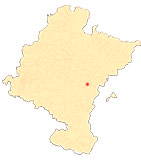The church of Santa María de Ujué
By Ignacio Miguéliz Valcarlos
Ship
As in the monastery of Leire, in the church of Santa María de Ujué, attached to the Romanesque chevet, although not in line with it, there is a large Gothic nave that can be dated between 1330 and 1387. It is a usual model in Navarrese Gothic architecture, of which several examples are preserved, but in this case it stands out for its width, almost 15 meters. It is articulated by means of three sections covered by ribbed vaults, with very molded ribs, following models of the radiant Gothic very similar to those of the church of San Saturnino of Pamplona and the Barbazana chapel of the cathedral, and it has a high choir located at the foot. It is illuminated by an oculus in the gable wall and three large windows in the wall on the Epistle side, of small dimensions since its construction was conditioned by the tower, the doorway and the stairway leading up to the choir.
It has a rich sculptural decoration centered above all on the keystones, capitals and corbels, in addition to the parapet of the choir and the doorways, of great importance in Navarrese Gothic, most of which derive from the sculpture of the cloister of the cathedral of Pamplona, as well as from groups in the churches of San Pedro and Santa María de Olite. On the keystones of the vaults there is a quartered shield with the arms of Navarre and France stamped with a crown, the coat of arms of Ramón de Sellán (1359-1391), abbot of Montearagón, the Pantocrator with the Tetramorphos, the Virgin and Child and an eagle, probably that of Saint John; while in the baskets that finish off the pilasters this decoration is articulated by means of hunting scenes, fantastic figures and animals and vegetal elements.
In the nave of the Epistle we can see a pulpit with its tornavoz, work of the master sculptor Vicente Frías, made between 1729 and 1754. It presents a rich decoration of vegetal elements, ribs and cherubs, that frame in the parapet the figures of the evangelists and in the tornavoz shields, among them the coat of arms of Navarre.
-
CLAVERÍA ARANGUA, J., Historia documentada de la Virgen, del santuario y villa de Ujué, Pamplona, 1953.
-
FERNÁNDEZ-LADREDA AGUADÉ, C., (Dir.), El arte románico en Navarra, Pamplona, 2004.
-
FERNÁNDEZ-LADREDA AGUADÉ, C., and GARCÍA GAINZA, M.ª C., Salve. 700 years of Marian art and devotion in Navarre, Pamplona, 1994.
-
GARCÍA GAINZA, M.ª C., and others, Catalog Monumental de Navarra. III. Merindad de Olite, Pamplona, 1985.
-
LAZCANO MARTÍNEZ DE MORENTÍN, M.ª R., (Coord.), Santa María de Ujué, Pamplona, 2011.
-
URANGA, J. J., Ujué medieval, Pamplona, 1984.











